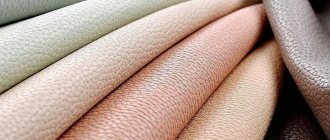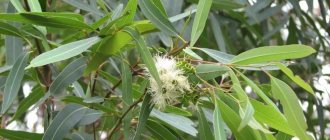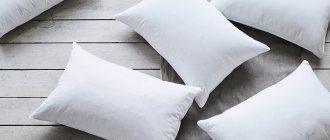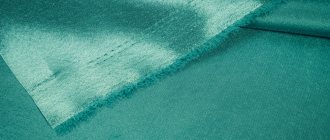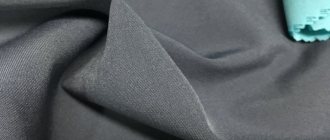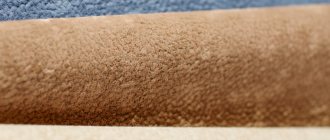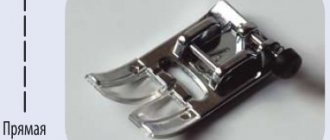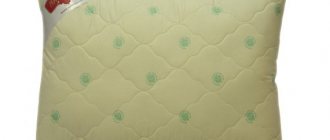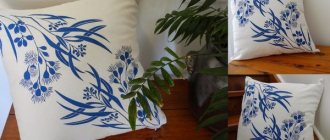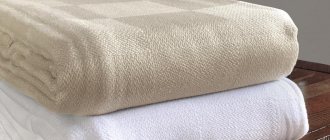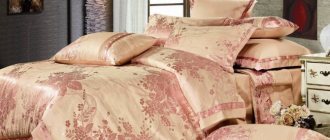Textile products made from bamboo appeared on the market not so long ago, but have already become favorites in sales. This fiber is used for towels, bed linen, children's clothing and knitwear, elegant and casual clothing for adults; many leading designers regularly present new collections of bamboo clothing.
This innovative material has many unique features, primarily for supporters of a healthy lifestyle, and their reviews of bamboo fiber and fabric made from it are unanimous and positive.
Secrets of bamboo fiber production
The traditional option for obtaining bamboo fiber involves mechanical processing of raw materials.
The bamboo is crushed, then fermented until smooth, after which the individual fibers are separated from it. The resulting product is ideal for the production of textiles and fillers. All fibers have the same density, length and strength. However, this option for producing bamboo fiber requires significant effort and time. For this reason, large-scale production uses a modern chemical method for processing raw materials. Is the bamboo fiber obtained this way dangerous? What is this - a chemical option for processing natural raw materials?
The use of special reagents can significantly simplify and speed up the fiber processing process. Moreover, the final product is completely safe for the consumer, since all chemicals are removed during production.
What kind of material
The material described is also called “bamboo fabric,” although this is incorrect. We are talking about specially produced fibers, which are then used both for the production of woven fabrics and as fillers. They are quite soft to the touch, reminiscent of any other plant material and are suitable for making fabric. Clothes made from such raw materials are light, breathable, and comfortable. Often it is used to sew bedding sets.
The question arises, what is bamboo fiber: synthetic or not? The answer here is ambiguous. The textile industry uses bamboo fiber, a natural raw material obtained from the plant of the same name.
It can be extracted mechanically, and then there will be no impurities. Materials obtained from this fiber are called “bamboo flax”. They are expensive and completely natural. However, more often, to speed up and reduce the cost of the process, manufacturers use a chemical method that allows them to obtain adhesive fibers, the further processing of which is much simpler. This is “bamboo viscose”, which has approximately the same properties as rayon. We are talking about artificial material here. True, all chemical impurities are washed out of it, and as a result the fabric turns out to be environmentally friendly.
Bamboo thread is used to make fabrics. This is the main similarity of all varieties of unique textiles. It is difficult to distinguish them from the more familiar natural ones (cotton, linen): in such clothes it is light, free, and the body does not sweat. Today, consumers often ask the question: which blanket is better, wool or bamboo? The second one is easier, and at the same time retains heat well. However, before choosing, you need to get acquainted in detail not only with the raw materials and the fabric obtained from them.
Description
The description of bamboo fabric is not much different from other natural materials. The raw material for it is the fibers of the plant of the same name. Growing bamboo is an economically profitable business. Firstly, the plant requires virtually no care. Pests and bacteria avoid it themselves, and it is resistant to adverse weather. Secondly, cut bamboo grows back very quickly, so production is almost continuous.
The properties of the fabric are in many ways similar to any other natural materials: soft, has a pronounced antibacterial effect, does not cause allergic reactions, and is suitable for sensitive or children's skin. Summer clothes, home models, and various textiles are made from such fabrics: towels, blankets, sleeping sets, etc.
The fabric is used to make medical uniforms, tracksuits and fashionable everyday items, including warm ones. It is difficult to say unequivocally which is better, bamboo or cotton. Here, each consumer chooses independently, based on a set of characteristics and practicality.
Advantages of bamboo fiber
Bamboo fabrics have a natural shine and smoothness.
Products made from them are very soft to the touch, more delicate than cotton. Bamboo fiber has a high density. Thanks to this characteristic, it does not wrinkle, is easy to drape and perfectly holds its given shape. Bamboo fiber also has all the traditional advantages of natural fabrics. What it is is easy to understand from the first use of bed linen made from this material. The fabric is breathable and highly hygroscopic. Thanks to this, it perfectly retains the heat of the human body in winter and prevents overheating in summer.
Bamboo is also used to make environmentally friendly filling for blankets and pillows. Bamboo fibers do not cause allergies, do not accumulate static electricity, and have antibacterial properties. Evergreen grass is never attacked by insect pests and does not rot. Accordingly, products made from bamboo fiber are durable. They also have natural protection against bacteria and parasites.
How to properly care
When purchasing an item that contains bamboo threads, you must immediately familiarize yourself with the washing and ironing rules indicated on its label and strictly follow them. In general, it is assumed that this material can be washed by hand or on a gentle machine cycle at 30 degrees. You should use mild detergents that do not contain bleaches, and it is better not to use the spin mode. Items that are well straightened out during drying do not need to be ironed, but if necessary, this can be done in the “Silk” mode, without steaming or splashing with water.
Blend products, in which the share of bamboo does not exceed 70%, can be washed at 40 degrees and pressed at a speed of no more than 400, the same applies to denim items. However, you need to remember that this fiber takes much longer to dry than cotton. In addition, when storing things, it is better to keep them in dry places, providing good air access.
Pillows and blankets with bamboo filling should be ventilated regularly; they are not afraid of sunlight and sources of artificial heat if the temperature does not exceed 30 degrees. If washing is necessary, it is done in a gentle mode with a low speed, without using bleaches and conditioners. To dry, the pillow or blanket should be positioned horizontally, it is advisable to provide air access to the bottom side. Such bedding should be stored in a dry and warm place, without packaging (this also applies to new products), regularly ventilated and beaten.
Disadvantages of bamboo fiber
According to some experts, bamboo will very soon displace the most common cotton today from the textile industry market.
Indeed, bamboo fiber has a lot of advantages, and the cost is quite reasonable. What about the disadvantages? As a raw material for making fabrics and a filler, bamboo fiber attracts manufacturers because it is highly hygroscopic. The ability to quickly absorb large amounts of moisture is usually considered an advantage of natural materials. But in some cases it is a disadvantage. Bamboo products are not the best option for constant use in high humidity conditions.
Story
Bamboo fabric has a short history. The first samples appeared no more than fifteen years ago, but it immediately became clear that the fabric had enormous potential. What is it due to?
Firstly, the fact that bamboo grows at tremendous speed. Let's say more, this is the fastest growing plant on the planet.
Secondly, bamboo grows on its own. It requires no maintenance, no watering, no use of chemicals to protect against pests. Consequently, there is also no need for a huge number of workers to look after the bamboo plantations. At the same time (just think about this figure!) – from one hectare of land you can get 10 times more bamboo than cotton.
Thirdly, bamboo benefits nature because... It will release 40 times more oxygen into the atmosphere than ate.
Bamboo fabric also has unique performance characteristics and benefits health. Read more about this.
Application area
In modern industry, bamboo fiber is used to make fillers and fabrics. Due to its characteristics, bamboo is ideal for creating clothing and home textiles. Bamboo fiber also has positive reviews as a natural filler for pillows and blankets. These bedding can be washed in a washing machine and dried outdoors.
Bed linen, protective covers for mattresses and pillows, tablecloths, and towels are also made from bamboo fiber. Bamboo fabrics are also used for sewing casual clothing, sports kits, and medical equipment.
Combination with other fibers
On some types of products you can find the inscription “charcoal bamboo”. These are fibers to which charcoal has been added for greater absorption. Reusable diapers are produced from coal, they have an antibacterial effect. After 3-4 washes, the material also stops absorbing everything bad, but it’s easy to bring it back to life - you just need to wash it in hot water.
Bamboo products are also made with the addition of cotton. This is how, for example, some types of blankets are produced. The combination of two natural materials combines positive qualities and increases the life of the product.
Clothes, bedding and blankets made of bamboo fiber: reviews
Bamboo products today can be purchased at any large textile store.
When purchasing, do not hesitate to examine the item you like in detail. Real bamboo is very soft and pleasant to the touch. It does not crunch when compressed and easily restores its shape after deformation. Remember also that any natural material cannot be cheap. But is real bamboo really that good? A blanket made of bamboo fiber has positive reviews due to its softness, wear resistance and lightness. You can sleep under this product all year round.
Clothing and home textiles made from bamboo perfectly absorb liquid, are incredibly pleasant to the touch, and retain an attractive appearance for a long period of time. If you believe the reviews, it is enough to purchase at least one product made from this material in order to personally appreciate bamboo fiber. Today, more and more of our compatriots are learning what it is. Try the incredible softness and lightness of natural bamboo fiber!
Bamboo wallpaper
Today, environmentally friendly materials are also in demand when decorating premises. Bamboo wallpaper fully meets this criterion; they can be used in interiors of a wide variety of styles:
- country;
- Provence;
- minimalism;
- ecodesign;
- Japanese style.
Bamboo fabric retains its natural texture. The finishing material is a decorative coating consisting of slats of the same color shade. The quality of bamboo wallpaper depends on compliance with the drying technology. The width of the bamboo slats varies from 5 to 25 mm; they are then attached to a fabric or paper base with glue having a natural composition. Wall coverings are produced in rolls.
These wallpapers last up to 10 years. The coating does not fade, is resistant to mechanical damage, and hides minor unevenness in the walls. In the interior, such wallpaper is not used for continuous pasting. As a rule, they are used to create a decorative panel, or use them to highlight an accent wall. Pasting with bamboo canvas presents certain difficulties, so it is better if a professional does this work.
What to glue bamboo fabric to
Several types of glue are suitable for applying bamboo wallpaper. The walls must first be cleaned of the old coating, leveled, and primed. Suitable for attaching bamboo wallpaper:
- PVA glue (cannot be used in rooms with high humidity);
- parquet glue;
- "liquid Nails";
- rubber based adhesive.
The surface to be pasted must be dry and smooth. The wallpaper will peel off from a damp base. The glue is applied both to the wall and to the canvas. After this, the adhesive layer should dry for 5-10 minutes. The edges of the canvas are smeared with a large amount of glue.
Despite its relatively high cost, bamboo is in demand in the textile, construction industries and other fields. This material is supported by its naturalness, safety, hypoallergenicity, and hygroscopicity. Many types of clothing, home textiles, and bedding are made from bamboo fabric. Bamboo has also found application as a finishing material for covering walls.
Reviews
Reviews clearly demonstrate not just the loyal attitude of consumers towards bamboo bed linen, but real trust in the manufacturers of such products. Over the years that bamboo has gone from an exotic novelty to a full-fledged textile material, a lot of good things have been said about it.
Galina M., Volgograd
“When I was first given this kind of underwear, I didn’t like it: I like more colorful colors, and besides, the word “bamboo” somehow didn’t fit with the underwear I’d have to sleep on. But in practice everything turned out to be much better, and even my husband, who can sleep on bare boards, praised the soft sheets and cozy blanket.”
Evgeniya, 29 years old
“The first impressions of a set of bamboo bed linen are soft, warm, delicate and a little rustling. Issues of comfort are extremely important for me as a person who values peaceful rest and healthy sleep, but as a housewife I can say: at first I struggled with this set for a long time, since it requires special conditions when washing. However, after a few months I got used to it and don’t consider hand washing, recommended by the manufacturer, something terrible.”
Sergey S., 32, Penza
“If my friends had not given me such linen, I would hardly have known that such a thing existed: before that, I associated bamboo with furniture, paper, the Chinese - with anything, but not with linen. However, I was pleasantly surprised by the quality of this material: it is quite comfortable to sleep, and they also say that it is 100 percent natural material, and natural means harmless. Many people on the Internet complain about problems with washing. I am a bachelor, and I do all the housework myself, so I can confidently say: the only problem that arose for me personally is that sometimes I forget it on the balcony in the sun, which is why the drawing faded in a few months, but for me personally this is not critical.”
As you can see, most consumers are at least satisfied with the quality of bamboo bed linen, because it is not only easy to wash, but also gives coziness and comfort while sleeping.
What else does a modern person need, who very often at the end of the working day wants only one thing - to get to his favorite bed and have a good rest?
Interesting to know
- The UN highly appreciated the properties of the plant and established International Bamboo Day, which is celebrated on September 18.
- In the territory of the former USSR, bamboo grows on the Black Sea coast of the Caucasus. They started growing it here back in Soviet times (in the middle of the last century).
- Not only bamboo clothing, but also bed linen are beyond praise.
- The high environmentally friendly properties of the material have led to the production of PC parts - laptop cases - from bamboo. In China, bamboo is also used to make paper, medicine, and vinegar.
- Bamboo is an evergreen plant. Those who want to grow bamboo at home will highly appreciate this property.
- Bamboo is a plant of the 21st century. It allows you to preserve forests in many countries of the world and make empty areas useful.
Types of fabric
Types of bamboo fabric depend on the production method:
Bamboo linen
It is made mechanically and is considered more environmentally friendly. This material is more expensive due to complex and slow production, but is higher in quality. Bamboo linen is more uneven and rough to the touch.
Bamboo viscose
Its second name is artificial bamboo silk. This material is made chemically, so its price is lower. It is softer and silkier than bamboo linen.
